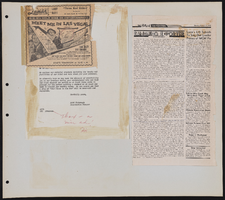Search the Special Collections and Archives Portal
Search Results
CER Corporation Photograph Collection of Henderson, Nevada Aerials
Identifier
PH-00275
Abstract
CER Corporation Photograph Collection of Henderson, Nevada Aerials consists of color photographic prints taken on June 6, 1980. The images are aerial views of Henderson, Nevada and were primarily used to document unused land.
Archival Collection
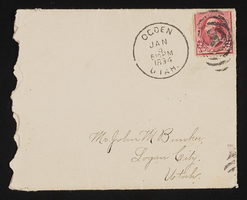
Letter and envelope to John M. Bunker, Logan City, Utah from Mary Etta Syphus, Ogden City, Utah
Date
1894-01-01
Archival Collection
Description
From the Syphus-Bunker Papers (MS-00169). The folder contains an original handwritten letter, an envelope, a typed transcription of the same letter, and a copy of original letter attached.
Text
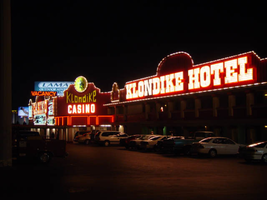
Photographs of Klondike signs, Las Vegas (Nev.), 2002
Date
2002
Archival Collection
Description
Daytime and nighttime views of the Klondike Hotel and Casino signs on the Strip. Information about the sign is available in the Southern Nevada Neon Survey Data Sheet.
Site address: 5191 S Las Vegas Blvd
Sign details: The Klondike Motel Casino is located on the east side of the strip, just north of the Las Vegas Tourist Bureau, actually sharing the same lot. The two are only separated by a small driveway. The mining town theme is exemplified throughout the exterior of the property with a western style text, seen on other similar themed properties such as the Frontier. Murals depicting scenes of prospecting miners and saloons adorn the surface as well as red steel sides which appears as wood, because of its horizontal panels. The property stretches north/south with a small parking lot separating the street from the establishment. Behind the front building a series of structures house the rooms. The buildings signage is situated along the face of the building, on the elevated surface of the walls themselves.
Sign condition: Structure 4 Surface 4 Lighting 3
Sign form: Fascia
Sign-specific description: The top edge of the wall entire face of the building arches, and steps up in various places, and is lined with gold raceways lined with incandescent bulbs. On the north side of the main building upon a vast paneled steel surface the word "Casino" is spelled in giant gold channel letters painted white on the interior. They are bordered in red neon and filled with incandescent bulbs. The text for the establishment is the western type face seen in properties such as the Frontier, or the Westward Ho. To the right of the text, an internally lit, white faced, plastic message board message board, is housed in a gold painted steel cabinet. Moving around the corner to the west face of the property, we see "Casino" spelled in the same manner of Cannel letters, flanked on either side by gold painted housings for cabinets, both crowning with an arched top. Incandescent bulbs forma border around the housing. Set inside each one of the square recessed areas is an internally lit, white, plastic faced message center, with vinyl lettering. Both cabinets are painted red. Below the main text an internally lit, white plastic faced, message center, with rounded ended runs the length of the space underneath the letters. The main entrance is underneath an awning, facing southwest. In the center of the top edge of the vertical wall above the awning, a circular internally lit cabinet is bordered with a gold raceway lined with incandescent bulbs. The surface of the sign is yellow plastic with the cartoon image of a dancing miner, complete with pick-axe. Below that Klondike is spelled with metallic channel letters with yellow plastic faces. The text descends in size toward the center of the text, then swells back to the original size on the sides. Below this, "Casino" is spelled in all capital, channel letters, filled with incandescent bulbs and bordered in neon. They are treated gold on the exterior and white in the interior. The awning cover the entrance, and is treated with neon as well. The face of the square awning is designed with three square recessed panels, with open bottoms. Three tubes of neon line each one of the three closed edges. Each tube takes a turn illuminating, red yellow, and blue. Cantilevered off of the left-hand side of the entrance roof line, a horizontal black cabinet reads "Vacancy" painted in white, and overlaid with red neon. The all caps text faces north/south. Continuing south along the face of the building, a two leveled stretch of structure, continues the last portion of the main building. On the red steel fascia continuing, above the overhang of the second level, "Klondike Hotel" is spelled in large channel letters, treated the same as those seen on the north face of the structure. They are painted gold on the exterior and white on the interiors, filled with incandescent bulbs and bordered with neon. To the left of the text, one on the golden housings for the cabinet, seen on the northern end of the west face, is present but empty. The edge of the overhang, beneath the text is also lined with a raceway and incandescent bulbs
Sign - type of display: Neon; Incandescent; Backlit
Sign - media: Steel; Plastic
Sign - non-neon treatments: Paint
Sign animation: Chasing, oscillating
Notes: The text which spells casino flashes on and steady burns, then oscillates, steady burns again, then shuts off. Moving around the corner to the western face, all the raceways bordering all the elements chase each other, while the incandescent bulbs located within the text which spells, "Casino" oscillate rapidly. The awning adorned with neon also animates, changing color flashing from red, then blue, then gold. The text which reads "Casino" above the awning is filled with incandescent bulbs which oscillate as well. The incandescent bulbs in the main text on the southern half of the western face of the building light up one letter at a time then once they are all illuminated, then they all begin to oscillate. Once they oscillate for a few seconds, then they all light up once again. The sequence is ended once all the letters go dark.
Sign environment: Located just north of the tourist bureau, the Klondike has the honor of being the first casino a traveler encounters as they enter the Strip. Besides the company of the tourist bureau and the Welcome to Las Vegas sign, it stands rather solitary. It's collection of pulsating bulbs and neon make the Klondike the most dominant force in its presence.
Sign - date of installation: 1978
Sign - date of redesign/move: Before the Klondike was opened twenty five years ago, it was known as the Konakai Motel.
Sign - thematic influences: mining, goldrush--small roadside motels
Surveyor: Joshua Cannaday
Survey - date completed: 2002
Sign keywords: Chasing; Oscillating; Fascia; Neon; Incandescent; Backlit; Steel; Plastic; Paint
Site address: 5191 S Las Vegas Blvd
Sign details: The Klondike Motel Casino is located on the east side of the strip, just north of the Las Vegas Tourist Bureau, actually sharing the same lot. The two are only separated by a small driveway. The mining town theme is exemplified throughout the exterior of the property with a western style text, seen on other similar themed properties such as the Frontier. Murals depicting scenes of prospecting miners and saloons adorn the surface as well as red steel sides which appears as wood, because of its horizontal panels. The property stretches north/south with a small parking lot separating the street from the establishment. Behind the front building a series of structures house the rooms. The buildings signage is situated along the face of the building, on the elevated surface of the walls themselves.
Sign condition: Structure 4 Surface 4 Lighting 3
Sign form: Fascia
Sign-specific description: The top edge of the wall entire face of the building arches, and steps up in various places, and is lined with gold raceways lined with incandescent bulbs. On the north side of the main building upon a vast paneled steel surface the word "Casino" is spelled in giant gold channel letters painted white on the interior. They are bordered in red neon and filled with incandescent bulbs. The text for the establishment is the western type face seen in properties such as the Frontier, or the Westward Ho. To the right of the text, an internally lit, white faced, plastic message board message board, is housed in a gold painted steel cabinet. Moving around the corner to the west face of the property, we see "Casino" spelled in the same manner of Cannel letters, flanked on either side by gold painted housings for cabinets, both crowning with an arched top. Incandescent bulbs forma border around the housing. Set inside each one of the square recessed areas is an internally lit, white, plastic faced message center, with vinyl lettering. Both cabinets are painted red. Below the main text an internally lit, white plastic faced, message center, with rounded ended runs the length of the space underneath the letters. The main entrance is underneath an awning, facing southwest. In the center of the top edge of the vertical wall above the awning, a circular internally lit cabinet is bordered with a gold raceway lined with incandescent bulbs. The surface of the sign is yellow plastic with the cartoon image of a dancing miner, complete with pick-axe. Below that Klondike is spelled with metallic channel letters with yellow plastic faces. The text descends in size toward the center of the text, then swells back to the original size on the sides. Below this, "Casino" is spelled in all capital, channel letters, filled with incandescent bulbs and bordered in neon. They are treated gold on the exterior and white in the interior. The awning cover the entrance, and is treated with neon as well. The face of the square awning is designed with three square recessed panels, with open bottoms. Three tubes of neon line each one of the three closed edges. Each tube takes a turn illuminating, red yellow, and blue. Cantilevered off of the left-hand side of the entrance roof line, a horizontal black cabinet reads "Vacancy" painted in white, and overlaid with red neon. The all caps text faces north/south. Continuing south along the face of the building, a two leveled stretch of structure, continues the last portion of the main building. On the red steel fascia continuing, above the overhang of the second level, "Klondike Hotel" is spelled in large channel letters, treated the same as those seen on the north face of the structure. They are painted gold on the exterior and white on the interiors, filled with incandescent bulbs and bordered with neon. To the left of the text, one on the golden housings for the cabinet, seen on the northern end of the west face, is present but empty. The edge of the overhang, beneath the text is also lined with a raceway and incandescent bulbs
Sign - type of display: Neon; Incandescent; Backlit
Sign - media: Steel; Plastic
Sign - non-neon treatments: Paint
Sign animation: Chasing, oscillating
Notes: The text which spells casino flashes on and steady burns, then oscillates, steady burns again, then shuts off. Moving around the corner to the western face, all the raceways bordering all the elements chase each other, while the incandescent bulbs located within the text which spells, "Casino" oscillate rapidly. The awning adorned with neon also animates, changing color flashing from red, then blue, then gold. The text which reads "Casino" above the awning is filled with incandescent bulbs which oscillate as well. The incandescent bulbs in the main text on the southern half of the western face of the building light up one letter at a time then once they are all illuminated, then they all begin to oscillate. Once they oscillate for a few seconds, then they all light up once again. The sequence is ended once all the letters go dark.
Sign environment: Located just north of the tourist bureau, the Klondike has the honor of being the first casino a traveler encounters as they enter the Strip. Besides the company of the tourist bureau and the Welcome to Las Vegas sign, it stands rather solitary. It's collection of pulsating bulbs and neon make the Klondike the most dominant force in its presence.
Sign - date of installation: 1978
Sign - date of redesign/move: Before the Klondike was opened twenty five years ago, it was known as the Konakai Motel.
Sign - thematic influences: mining, goldrush--small roadside motels
Surveyor: Joshua Cannaday
Survey - date completed: 2002
Sign keywords: Chasing; Oscillating; Fascia; Neon; Incandescent; Backlit; Steel; Plastic; Paint
Mixed Content
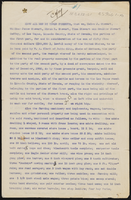
Stewart family real estate documents
Date
1900 to 1909
Archival Collection
Description
Stewart family real estate documents
Text
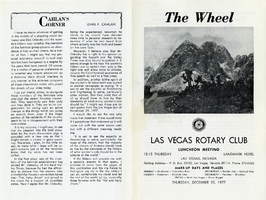
The Wheel Las Vegas Rotary Club newsletter, December 22, 1976
Date
1976-12-22
Archival Collection
Description
Newsletter issued by the Las Vegas Rotary Club
Text
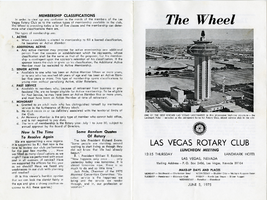
The Wheel Las Vegas Rotary Club newsletter, June 5, 1975
Date
1975-06-05
Archival Collection
Description
Newsletter issued by the Las Vegas Rotary Club
Text

Transcript of interview with Herbert C. Wells by Dr. David Emerson, March 8, 2006
Date
2006-03-08
Archival Collection
Description
Herbert C. Wells is currently professor emeritus of civil and environmental engineering at UNLV, and is considered the father of engineering at the university. He was born in Omaha, Nebraska, in 1927, and spent the first four years of his life there. After his father was killed in a plane crash in 1931, his mother moved them out to Los Angeles to be near her husband's parents. They moved several times, but the goal was always to find good schools for Herb and his sister Herb received an outstanding junior high education at Trailfinders School for Boys, and then attended Woodrow Wilson Junior High School in ninth grade. He then was sent to the San Diego Army Navy Academy, where he completed high school in two years and graduated at age 16. He next enrolled at Pasadena Junior College, majoring first in chemistry and then in geology, and was drafted into the army at age 18. After the war, Herbert returned to Berkeley to finish his education. The GI bill helped him finish his master's degree. He then went to work for United Geophysical for two years, and following that, was hired at a mine in Climax, Colorado. He and his second wife moved to Las Vegas in 1957, where he began working for Titanium Metals. After a mere three weeks on the job, he met with Dr. Malcolm Graham from early UNLV, who asked Herb to teach surveying. Dr. Wells taught surveying for only one semester, but continued his association with the faculty at the university. He kept working at Titanium Metals, where he learned a lot of practical chemistry, but was laid off shortly thereafter. He then was offered a job with Blue Diamond Gypsum as a plant engineer and continued teaching on a part-time basis. He became a full-time instructor at the college in 1961. By 1967, Herbert had been appointed chairman of science, math, and engineering. He immediately put in a request for ten more teaching positions, which were ultimately filled. He also was instrumental in putting together a proposal for a graduate degree in physics, and of course was involved in ABET accreditation for engineering degrees.
Text
Pagination
Refine my results
Content Type
Creator or Contributor
Subject
Archival Collection
Digital Project
Resource Type
Year
Material Type
Place
Language
Records Classification

